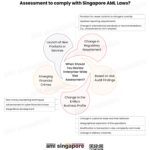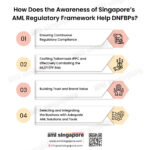eBook for Risk-Based Approach in AML Compliance
eBook for Risk-Based Approach in AML Compliance
The principal regulations in Singapore on anti-money laundering and combating the financing of terrorism (AML/CFT) require a risk-based approach. The risk-based approach, with the revised application by the FATF recommendation, is paramount in establishing effective AML/CFT programs. It provides a system that helps to assess and understand the money laundering and terrorist financing risks to which they are exposed and further take the necessary actions. It also helps with evaluations and customer risk profiling very efficiently and effectively.
This guide will help discover and implement a risk-based approach while looking into the legal and regulatory framework.
Moreover, this eBook contains a detailed analysis of risk-based approaches for AML compliance, such as:
- Introduction to Risk-Based Approach
- History of Risk-Based Approach
- Principle of the Risk-Based Approach (RBA)
- Risk-Based Approach to AML Framework
- Benefits of a Risk-Based Approach
- Commonly Employed Controls by companies adopting the Risk-Based Approach
- Risk-Based Approach Examples
- Use of Technology in a Risk-Based Approach
With the help of the risk-based approach, safeguard your organisation against money laundering and terrorism financing while maintaining regulatory compliance. Check out our comprehensive guide, which unlocks the power of effective AML compliance with the risk-based approach.
Related Posts
Related Articles
- The risk-based approach in Anti-Money Laundering Compliance
- Signs It’s Time to Review Your Enterprise-Wide Risk Assessment (EWRA)
- Guide to Beneficial Owner under Singapore AML regulations
- Enhanced Due Diligence: Navigating the measures to manage high-risk under Singapore AML Laws
- Implement a Transaction Monitoring Program to strengthen the AML Efforts
- Key Terms and Concepts in the AML Compliance Program: Strengthening the AML Foundation
Related Laws
- Corruption, Drug Trafficking and Other Serious Crimes Act (Confiscation of Benefits), 1992 (CDSA)
- Accounting and Corporate Regulatory Authority’s (ACRA) AML/CFT Guidelines for Registered Filing Agents
- Guidelines for Regulated Dealers in the Precious Stones and Precious Metals Dealers Sector on Anti-Money Laundering/Countering the Financing of Terrorism
- Precious Stones and Precious Metals (Prevention of Money Laundering and Financing of Terrorism) Regulations, 2019
- Estate Agents (Prevention of Money Laundering and Financing of Terrorism) Regulations, 2021
- Guidelines for Regulated Dealers in the Precious Stones and Precious Metals Dealers Sector on Anti-Money Laundering/Countering the Financing of Terrorism
- Legal Profession (Prevention of Money Laundering and Financing of Terrorism) Rules, 2015
Related Videos
Related Infographics
- Singapore’s National Strategy for Countering the Financing of Terrorism
- Navigating the AML/CFT Regulatory Framework for DNFBPs in Singapore
- Factors for conducting Enterprise-Wide Risk Assessment under Singapore AML Laws
- Enterprise-Wide Risk Assessment under Singapore AML Regulations
- AML Record-Keeping in Singapore
- Must-Have Elements of the AML Program
- Unravelling AML Program Failures: Causes and Solutions
- AML/CFT Training Essentials: Know, Educate, Comply
- Responsibilities of Compliance Officer under Singapore AML Laws
- KYC Essentials: For Identifying the Customers under AML Singapore Laws
- Measures when CDD cannot be completed under Singapore AML Laws
- Transactions where Customer Due Diligence is required under Singapore AML regulations


